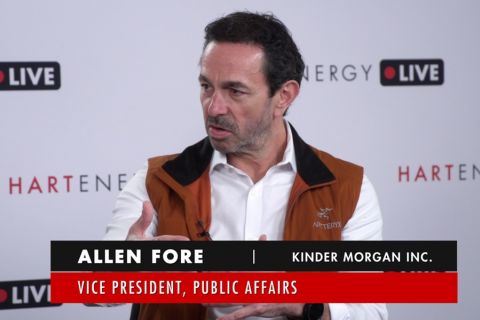
The hydrogen color wheel helps differentiate between production methods. However, even hydrogen in the same color category can have wide-ranging carbon footprints. (Source: Shutterstock)
It’s time to ditch the hydrogen color wheel, or rainbow, and focus on carbon intensity, according to an expert leading efforts to put industrywide protocols in place globally.
“The numbers you use, the way you decide to do the math, the way you choose to allocate carbon intensity, there are all of these areas where you can turn a dial to the left or the right. You can toggle a switch one way or another and change your answer,” Zane McDonald, executive director of the Open Hydrogen Initiative and a member of GTI Energy’s Strategy and Commercialization Group, told Hart Energy.
Many see hydrogen—which can power vehicles and supply electricity with no carbon emissions—playing an essential decarbonization role as the world seeks to lower emissions. The hydrogen color wheel helps differentiate between production methods. However, even hydrogen in the same color category can have wide-ranging carbon footprints.
Classifying hydrogen by feedstock used can have benefits—for example, enabling theoretical conversations about hydrogen, McDonald said. However, issues occur when policies, investment strategies and market transactions are made based on the color wheel generally focused on feedstock, instead of what really matters—carbon intensity.
“There’s a high degree of variability in the carbon intensity of hydrogen production, even when you’re using the same production technologies and even [with] the same primary energies,” McDonald said. “You lose all the nuance associated with the operation of a facility and how that impacts carbon intensity when you just paint with this broad-brush stroke and use the color wheel.
McDonald sat down with Hart Energy during CERAWeek by S&P Global to discuss OHI’s efforts to develop and implement global protocols, tools and best practices for assessing the carbon intensity of hydrogen.
Velda Addison, senior energy transition editor, Hart Energy (VA): How is carbon intensity measured today? Is there one technique that most people use? Is there a dominant protocol?
Zane McDonald, executive director, Open Hydrogen Initiative (ZM): In the U.S., we do have a dominant tool. The GREET [Greenhouse gases, Regulated Emissions, and Energy use in Technologies] model developed by Argonne National Lab is a gold standard in the U.S. for LCA [lifecycle assessment]. The challenge is that LCA is moving from an academic practice to something that’s beginning to be applied in industrial strategies. The markets are starting to use LCA. We’re increasingly seeing policies using LCA. We’re seeing this rise in ESG investing. The investment communities are interested in LCA and knowing what the carbon intensity of their portfolios is. With that, we’re starting to see that there’s not a one-size-fits-all solution. We need LCA practices that are bespoke for what we’re trying to understand. With that, we’re starting to see that while GREET is the gold standard in the U.S., you need something that is more tailor made for hydrogen. We need a gold standard globally because we are a global community in the energy space. We need something that doesn’t just hold water in the U.S., but holds water all around the world.
VA: When OHI is developing these protocols, what are some definite must-haves?
ZM: The first is transparency. We must have a structure that is easy to understand. You have to be able to pull the curtain back and see how things were done, and understand where the numbers came from, why they were used and why they were selected. We have to be really clear with that. We’re developing what’s called a unit process library. The unit process library is a way for you to know at every step of the hydrogen production value chain every technology, where there are materials and energy that goes in and materials and energy that goes out. There’s going to be essentially a folder in this unit process library that explains and characterizes that unit process. It says this is the energy going in and these are the materials going in; these are the energy materials coming out. Here are sources that back up our understanding of this technology. That is transparency to the nth degree. That gives you, as a user, all the power to understand the numbers. That’s so important. Transparency is the seed to marketplaces. It’s the seed to all of this. That’s a key part of this.
Also very important is to be operating at the facility level. A key aspect of moving beyond the color wheel is being able to talk about hydrogen’s carbon intensity at the individual asset [level] that’s producing hydrogen.
VA: OHI’s initial focus is as at the asset level, right? Do you have any plans to move to other parts of the supply chain and cover the whole spectrum?
ZM: We absolutely do. Right now, our systems boundary looks at drilling that well, cultivating some biomass, producing a solar panel or a wind turbine or whatever the case may be—wherever you get that primary energy—all the way down to any processing that has to happen for that primary energy and then to the hydrogen production facility. We’re stopping at the hydrogen production facilities plant gate. So, we have this big systems boundary. We do have ambitions to start to look downstream knowing that hydrogen is going to be used in ammonia. That ammonia is likely to be a globally traded commodity to move hydrogen. So, we are interested in ammonia and beginning to look at the carbon intensity of some transportation methods as well. I think the market is going to need that information.
VA: Who all is involved in this initiative?
ZM: This is my favorite part. The collaboration is really exciting for me. We have folks that have different commercial perspectives, folks that have different business strategies, folks have different perspectives of how markets should develop, all working toward the same goal. Mutual trust and working across the aisle are necessary components of what we’re doing. We have integrated majors. We have gas and power utilities. We have coalition groups and environmental NGOs. We have academics. We have governments. We’ve got Shell and Exxon, National Grid and EQT serving as Foundational Sponsors. We’re really thrilled with the type of collaboration that’s happening within OHI. We want to have an impact. GTI is a not for profit. We are going for impact, and collaboration will be key when we’re done. When we have these protocols and this methodology in place, we don’t have to go out to the industry and say, ‘Look what we created. Don’t you think it’s cool? Can we get your feedback?’ They’re already engaged. They’re already giving their thumbs up. So, when we’re done, we just hit the ground running. We start implementing right away, and that’s exciting. I think that’s really cool.
VA: Where are you all in the process? Where are your efforts focused right now?
ZM: We have just finished the unit process library, and that was a Herculean undertaking. Hydrogen is so flexible, and there are so many ways you can produce it. There are so many parts of the supply chain that feed into it. Characterizing all of those different technologies at the granular level was huge. It was a major undertaking. We had 47 researchers on our side, and we were working with another 50 subject matter experts from our industry stakeholders to do that. It was a massive marshaling of efforts. We’ve just completed that. Now we have all of the building blocks, and we’re going to start building the house. Now, we begin the real LCA work of beginning to develop the LCA tool alongside developing best practices and data quality, which is important to us in understanding the quality fidelity of the data that goes into the tool.
VA: When does OHI aim to roll out its protocols?
ZM: Pace is a huge component of what we’re doing. Moving quickly is key because things are happening so fast in hydrogen right now. We hope to have a minimum viable product of our whole tool kit by the end of Q3 of this year. At that point, we will start doing industry demonstrations, and we hope to have a tranche of industry demos done in Q1 2024. At that point, the tool will be vetted enough that it will be ready to do some public releases.
Recommended Reading
The Jones Act: An Old Law on a Voyage to Nowhere
2024-04-12 - Keeping up with the Jones Act is a burden for the energy industry, but efforts to repeal the 104-year-old law may be dead in the water.
Kinder Morgan Exec: Building Pipelines ‘Challenging, but Manageable’
2024-04-05 - Allen Fore, vice president of public affairs for Kinder Morgan, said building anything, from a new road to an ice cream shop, can be tough but dealing with stakeholders up front can move projects along.
FERC Again Approves TC Energy Pipeline Expansion in Northwest US
2024-04-19 - The Federal Energy Regulatory Commission shot down opposition by environmental groups and states to stay TC Energy’s $75 million project.
CEO: Linde Not Affected by Latest US Green Subsidies Package Updates
2024-02-07 - Linde CEO Sanjiv Lamba on Feb. 6 said recent updates to U.S. Inflation Reduction Act subsidies for clean energy projects will not affect the company's current projects in the United States.
Global Energy Watch: Corpus Christi Earns Designation as America's Top Energy Port
2024-02-06 - The Port of Corpus Christi began operations in 1926. Strategically located near major Texas oil and gas production, the port is now the U.S.’ largest energy export gateway, with the Permian Basin in particular a key beneficiary.





